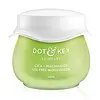What's inside
What's inside
 Key Ingredients
Key Ingredients

 Benefits
Benefits

 Concerns
Concerns

 Ingredients Side-by-side
Ingredients Side-by-side

Water
Skin ConditioningPropylene Glycol
HumectantCaprylic/Capric Triglyceride
MaskingHyaluronic Acid
HumectantXylitol
HumectantGlucose
HumectantAnhydroxylitol
HumectantNopalea Cochenillifera Extract
Skin ConditioningGlycerin
HumectantGlyceryl Stearate
EmollientPEG-100 Stearate
Dimethicone
EmollientPhenoxyethanol
PreservativeEthylhexylglycerin
Skin ConditioningCetearyl Alcohol
EmollientC15-19 Alkane
SolventStearic Acid
CleansingCetyl Palmitate
EmollientSodium Acrylate/Sodium Acryloyldimethyl Taurate Copolymer
Emulsion StabilisingIsohexadecane
EmollientPolysorbate 80
EmulsifyingCarbomer
Emulsion StabilisingSqualene
EmollientTrehalose
HumectantHydrolyzed Vegetable Protein
Skin ConditioningSodium Hydroxide
BufferingXylitylglucoside
HumectantDisodium EDTA
Ceramide Ng
Skin ConditioningGlycine Soja Sterols
EmollientWater, Propylene Glycol, Caprylic/Capric Triglyceride, Hyaluronic Acid, Xylitol, Glucose, Anhydroxylitol, Nopalea Cochenillifera Extract, Glycerin, Glyceryl Stearate, PEG-100 Stearate, Dimethicone, Phenoxyethanol, Ethylhexylglycerin, Cetearyl Alcohol, C15-19 Alkane, Stearic Acid, Cetyl Palmitate, Sodium Acrylate/Sodium Acryloyldimethyl Taurate Copolymer, Isohexadecane, Polysorbate 80, Carbomer, Squalene, Trehalose, Hydrolyzed Vegetable Protein, Sodium Hydroxide, Xylitylglucoside, Disodium EDTA, Ceramide Ng, Glycine Soja Sterols
Water
Skin ConditioningCyclopentasiloxane
EmollientDimethicone Crosspolymer
Emulsion StabilisingGlycerin
HumectantPolyacrylamide
C13-14 Isoparaffin
EmollientLaureth-7
EmulsifyingNiacinamide
SmoothingDivinyldimethicone/Dimethicone Copolymer
C12-13 Pareth-23
CleansingC12-13 Pareth-3
EmulsifyingSaccharide Isomerate
HumectantSilanetriol
Hyaluronic Acid
HumectantBenzyl Alcohol
PerfumingEthylhexylglycerin
Skin ConditioningTocopherol
AntioxidantMethylsilanol Mannuronate
Skin ConditioningAcrylates/C10-30 Alkyl Acrylate Crosspolymer
Emulsion StabilisingTocopheryl Acetate
AntioxidantAllantoin
Skin ConditioningSodium Hydroxide
BufferingDisodium EDTA
Laminaria Digitata Extract
Skin ProtectingCetyl-Pg Hydroxyethyl Palmitamide
Skin ConditioningCeramide 1
Skin ConditioningCeramide 2
Skin ConditioningCeramide 3
Skin ConditioningCeramide 4
Skin ConditioningCeramide 6 Ii
Skin ConditioningCentella Asiatica Extract
CleansingAvena Sativa Meal Extract
SoothingAloe Barbadensis Leaf Juice Powder
Skin ConditioningCamellia Sinensis Leaf Extract
AntimicrobialWater, Cyclopentasiloxane, Dimethicone Crosspolymer, Glycerin, Polyacrylamide, C13-14 Isoparaffin, Laureth-7, Niacinamide, Divinyldimethicone/Dimethicone Copolymer, C12-13 Pareth-23, C12-13 Pareth-3, Saccharide Isomerate, Silanetriol, Hyaluronic Acid, Benzyl Alcohol, Ethylhexylglycerin, Tocopherol, Methylsilanol Mannuronate, Acrylates/C10-30 Alkyl Acrylate Crosspolymer, Tocopheryl Acetate, Allantoin, Sodium Hydroxide, Disodium EDTA, Laminaria Digitata Extract, Cetyl-Pg Hydroxyethyl Palmitamide, Ceramide 1, Ceramide 2, Ceramide 3, Ceramide 4, Ceramide 6 Ii, Centella Asiatica Extract, Avena Sativa Meal Extract, Aloe Barbadensis Leaf Juice Powder, Camellia Sinensis Leaf Extract
 Reviews
Reviews

Ingredients Explained
These ingredients are found in both products.
Ingredients higher up in an ingredient list are typically present in a larger amount.
Disodium EDTA plays a role in making products more stable by aiding other preservatives.
It is a chelating agent, meaning it neutralizes metal ions that may be found in a product.
Disodium EDTA is a salt of edetic acid and is found to be safe in cosmetic ingredients.
Learn more about Disodium EDTAEthylhexylglycerin (we can't pronounce this either) is commonly used as a preservative and skin softener. It is derived from glyceryl.
You might see Ethylhexylglycerin often paired with other preservatives such as phenoxyethanol. Ethylhexylglycerin has been found to increase the effectiveness of these other preservatives.
Glycerin is already naturally found in your skin. It helps moisturize and protect your skin.
A study from 2016 found glycerin to be more effective as a humectant than AHAs and hyaluronic acid.
As a humectant, it helps the skin stay hydrated by pulling moisture to your skin. The low molecular weight of glycerin allows it to pull moisture into the deeper layers of your skin.
Hydrated skin improves your skin barrier; Your skin barrier helps protect against irritants and bacteria.
Glycerin has also been found to have antimicrobial and antiviral properties. Due to these properties, glycerin is often used in wound and burn treatments.
In cosmetics, glycerin is usually derived from plants such as soybean or palm. However, it can also be sourced from animals, such as tallow or animal fat.
This ingredient is organic, colorless, odorless, and non-toxic.
Glycerin is the name for this ingredient in American English. British English uses Glycerol/Glycerine.
Learn more about GlycerinHyaluronic acid is naturally found in healthy skin. It is a humectant, meaning it draws moisture to your skin.
This ingredient helps hydrate, soothe, and protect the skin.
What makes hyaluronic acid so hydrating? It has the capacity to bind or hold large amounts of water.
Fun fact: It is already naturally found in our bodies, such as the fluids of our eyes and our joints.
Studies find this ingredient to have anti-inflammatory and anti-microbial properties. This can help speed up wound-healing.
Hyaluronic acid can be irritating if the molecule has a low-molecular weight, or if the molecules are small.
One study found low-molecular weight hyaluronic acid to be pro-inflammatory, meaning some people may experience irritation. This is because our bodies use hyaluronic acid in the wound-healing process to signal to our bodies, via irritation, that something needs healing.
The same study found high-molecular weight hyaluronic acid to be anti-inflammatory.
These are some other common types of Hyaluronic Acid:
Learn more about Hyaluronic AcidSodium Hydroxide is also known as lye or caustic soda. It is used to adjust the pH of products; many ingredients require a specific pH to be effective.
In small amounts, sodium hydroxide is considered safe to use. However, large amounts may cause chemical burns due to its high alkaline.
Your skin has a natural pH and acid mantle. This acid mantle helps prevent harmful bacteria from breaking through. The acid mantle also helps keep your skin hydrated.
"Alkaline" refers to a high pH level. A low pH level would be considered acidic.
Learn more about Sodium HydroxideWater. It's the most common cosmetic ingredient of all. You'll usually see it at the top of ingredient lists, meaning that it makes up the largest part of the product.
So why is it so popular? Water most often acts as a solvent - this means that it helps dissolve other ingredients into the formulation.
You'll also recognize water as that liquid we all need to stay alive. If you see this, drink a glass of water. Stay hydrated!
Learn more about Water